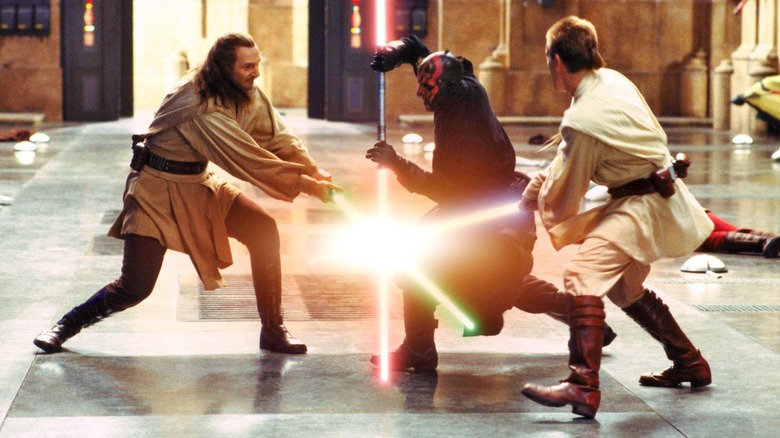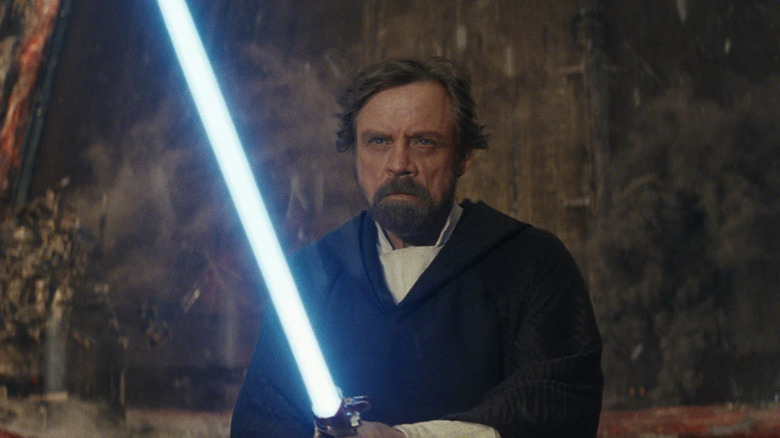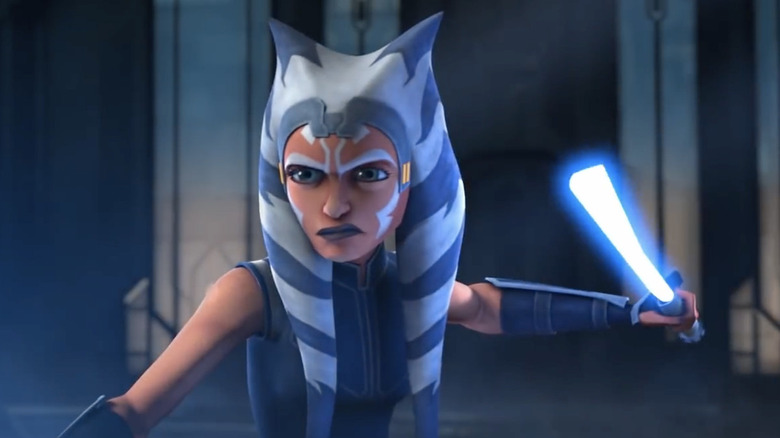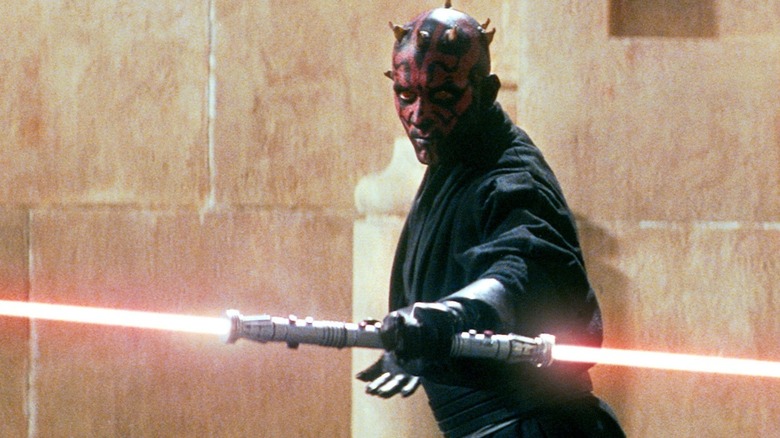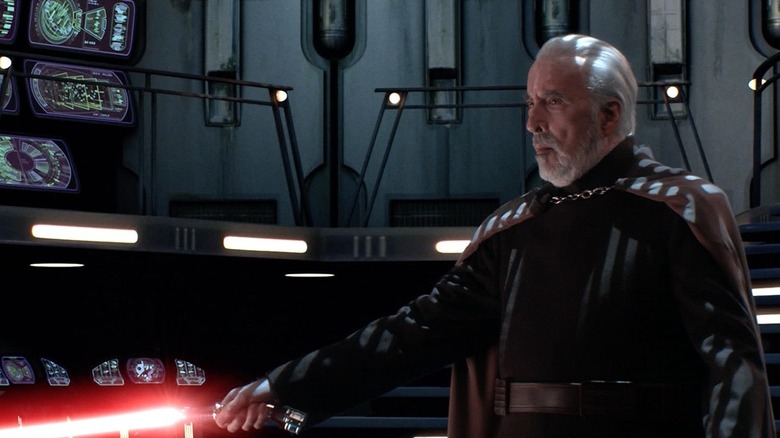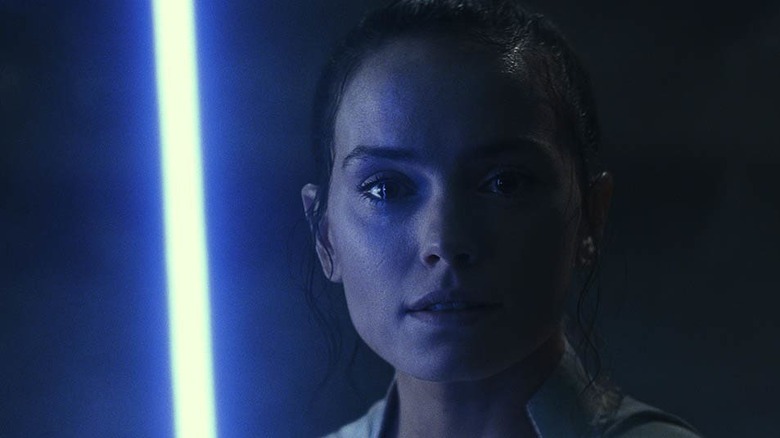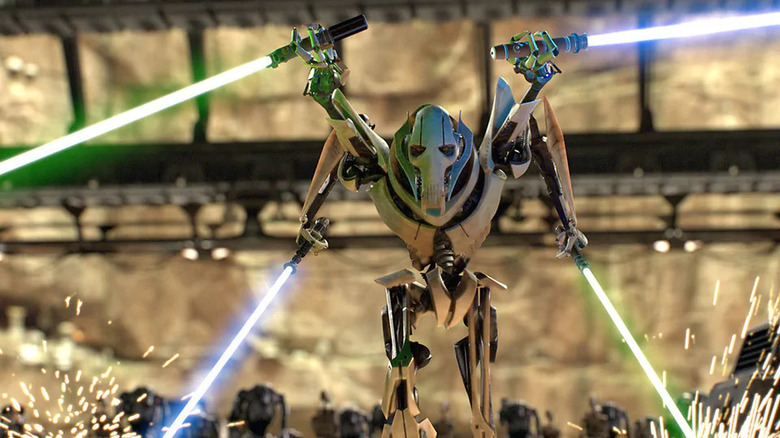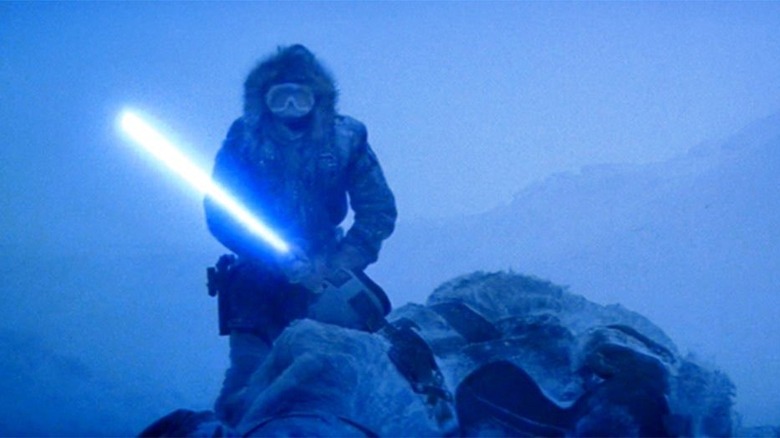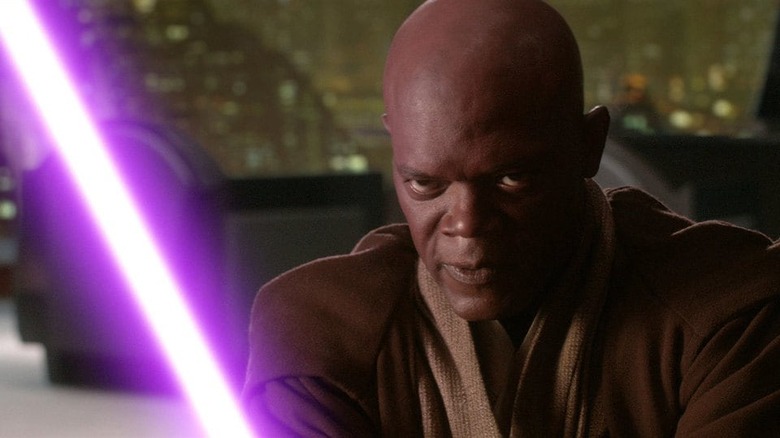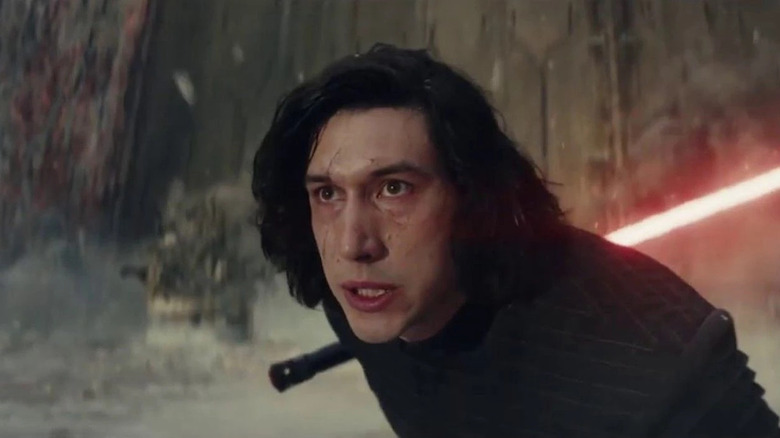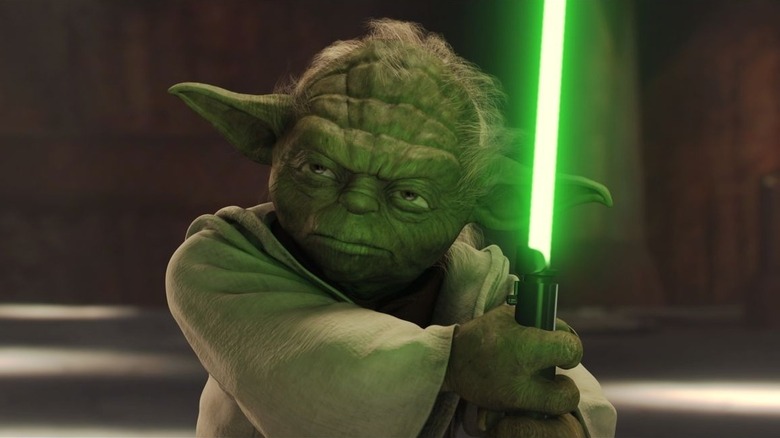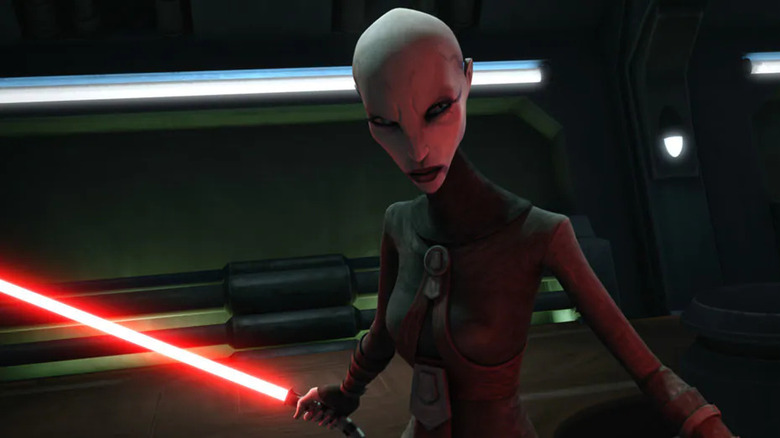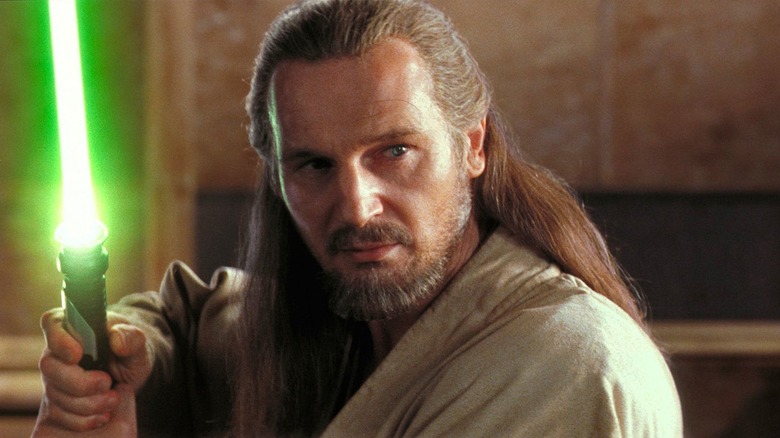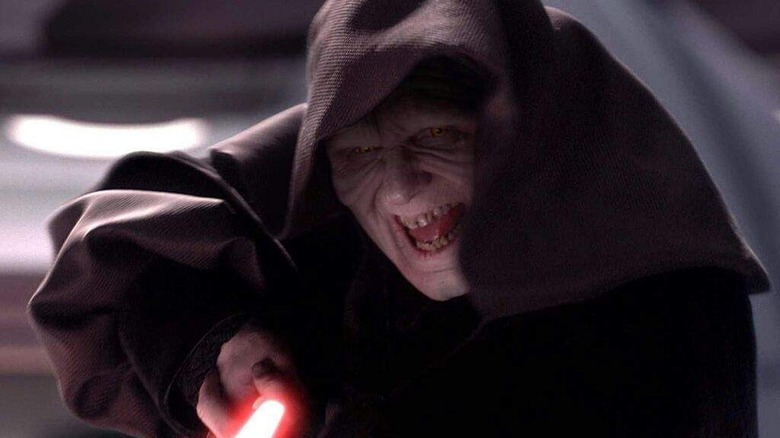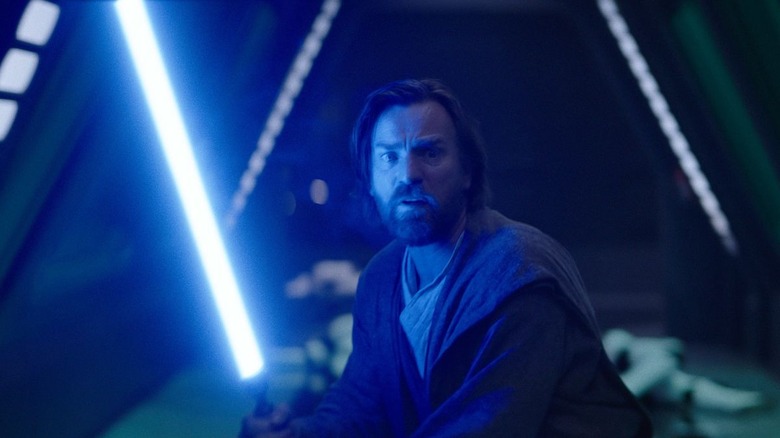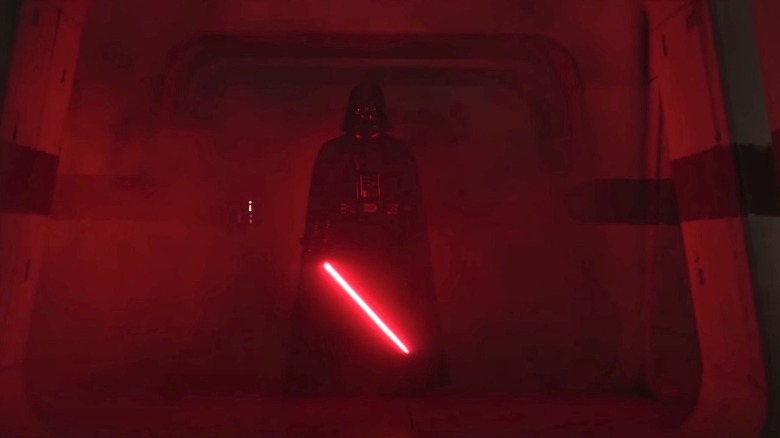What Each Star Wars Character's Lightsaber Fighting Style Really Means
Lightsaber combat is an integral part of Star Wars DNA. The franchise is an amalgamation of many different genres, and a "laser sword" combines the futurism of science fiction with the chivalry of medieval knights. Even if it doesn't feel as exciting today as it was in 1977, Obi-Wan Kenobi's (Sir Alec Guinness) duel with Darth Vader (David Prowse) in "Star Wars: Episode IV — A New Hope" established a key aspect of the saga. Luke Skywalker's (Mark Hamill) battles with Vader in "The Empire Strikes Back" and "Return of the Jedi" are more epic, and conclude with shocking plot twists. Lightsaber combat grew more exciting thanks to the Star Wars prequel trilogy, where Jedi Knights wielded their weapons when they were supposedly at the height of their powers.
The Star Wars sequel trilogy found the right balance between the ways that the previous trilogies depicted lightsaber duels. Although the highly-coordinated stunt work in the prequels looks amazing, the duels felt less naturalistic, whereas the ones in "The Force Awakens" and "The Last Jedi" were slightly rougher and more brutal. Here is what each Star Wars character's lightsaber fighting style really means.
Luke Skywalker
Luke's journey in the original trilogy isn't just about becoming a Jedi but also becoming a man. In "A New Hope," Luke is a brash teenager who still looks out into the stars with a sense of hope. By the end of "Return of the Jedi," he's gained confidence in his abilities. Luke never completes any formal training in lightsaber combat, merely learning how to block impending lasers thanks to Obi-Wan, but his mentor perishes before Luke learns about the art of chivalry. He's so eager to rescue Han Solo (Harrison Ford), Chewbacca (Peter Mayhew), and Princess Leia (Carrie Fisher) in "The Empire Strikes Back" that he doesn't get to complete his training with Yoda on Dagobah.
It's notable that when Luke duels Vader in Cloud City, he is the first to ignite his lightsaber, a violation of what Yoda taught him. Yoda says that "a Jedi uses the Force for knowledge and defense, never for attack." Luke is able to control his anger for the majority of "Return of the Jedi," but Vader lures him to attack when he threatens to turn Leia to the dark side. It's only after seeing his father's injuries that Luke realizes that he's strayed from the Jedi path. When Luke's projection duels with his nephew Kylo Ren (Adam Driver) in "The Last Jedi," eagle-eyed fans may have noticed that Luke does not create any tracks in the sand, indicating that his physical presence is not there.
Ashoka Tano
Ashoka Tano (Ashley Eckstein) wields her lightsaber in an unusual way. She ignites her weapon upside down, and in the beginning, she's usually on the defensive. Ashoka is proud of her training, but the reality of being a child soldier soon sets in. She is dealing with a tremendous amount of pressure in the 2008 film "Star Wars: The Clone Wars." Not only is she set to train with "The Chosen One," but she's assigned a mission to save Rotta the Hutt, which could turn the tide of the war.
Over time, Ashoka grows more assured of her abilities. She uses the defensive move to undercut her opponents, and surprisingly holds her own against dangerous villains like Asajj Ventress (Nika Futterman) and General Grievous (Matthew Wood). As a youngling, Ashoka had a strong relationship with Yoda, and — like the diminutive green Jedi — she uses her size to her advantage. Ashoka's nimble, acrobatic combat style shows her ability to surprise her enemies. When she shows up on "The Mandalorian," Ashoka duels at a slower pace. She has been weathered by age and saddened by the tragedy that she has seen. The less acrobatic way in which she slays the Calodan guards shows that there is a part of her Jedi training that she has left behind.
Darth Maul
Darth Maul (Ray Park) thrives on his ability to shock. Maul is overconfident in his abilities and doesn't realize that he is simply a pawn in Darth Sidious' (Ian McDiarmid) scheme to take over the galaxy. Maul was never the strategist that his master was. His blunt, theatrical style of fighting reflects his heritage on the planet Dathomir since Dathomirian Zabraks are trained from a young age to be ruthless killing machines. The double-bladed lightsaber that Maul wields in "Star Wars: Episode I — The Phantom Menace" is similar to the Dathomirian bo-staffs that are seen in "The Clone Wars."
Maul revels in his ability to show off his skills. He has awaited the chance to fight the Jedi and prove that he is worthy of aiding Sidious. Maul's erratic moves in his duel against Obi-Wan Kenobi (Ewan McGregor) and Qui-Gon Jinn (Liam Neeson) reflect his lack of control. When a shield temporarily cuts him off from his opponents, Maul angrily paces. He is infuriated that Qui-Gon is able to meditate in the midst of their battle.
Count Dooku
Count Dooku (Christopher Lee) grew up on the wealthy planet Serenno. He is extremely haughty and arrogant and believes that he is wiser than the Jedi Council. Dooku carries himself with formal elegance, and it's clear from the way that he attacks which of Dooku's opponents truly challenges him. He is simply toying with Anakin and Obi-Wan when he easily defeats them in "Attack of the Clones." However, Dooku shows his intensity when he battles Yoda. He wants to prove once and for all that he is more powerful than his former master.
Dooku's curved blade is unique in the Star Wars franchise. The unusual design allows Dooku to torment his opponents. In "Revenge of the Sith," he slices Obi-Wan to wound him, but this only provokes Anakin's anger. Christopher Lee claimed that he has appeared in more sword fights on screen than any other actor. Remarkably, at 79 he was able to perform most of the duels in "Attack of the Clones." However, his frantic battle with Yoda did require the use of a stunt double.
Rey
Let's start off by dispelling the "Mary Sue" nonsense altogether. Rey (Daisy Ridley) possesses a natural force sensitivity, but she has no idea how to use it. In "The Force Awakens," Rey only barely manages to survive her duel with Kylo Ren by chaotically swinging Luke's lightsaber. Kylo Ren is vulnerable, having already been shot by Chewbacca (Peter Mayhew), and he's recovering from the death of his father. Thus, Rey is able to take advantage of his fraught emotional state.
As Rey trains with Luke in "The Last Jedi," she begins to adopt his techniques into her style. She shows that she has grown to respect the will of the force. As a result, her attack moves are less chaotic. However, Rey shows that her training is still incomplete when she is nearly killed by Supreme Leader Snoke (Andy Serkis). She is so shocked by Kylo Ren's betrayal that she gives in to her blind rage.
General Grievous
General Grievous is not force-sensitive, relying on his cybernetic enhancements to wield four lightsabers at once. Grievous collects the lightsabers of the Jedi he has killed as trophies and his strategy is to simply overwhelm his opponents. In the "Star Wars: The Clone Wars" episode "Lair of Grievous," he surprises the Jedi Knight Nahdar Vebb by revealing his extra arms. He is still no match for a Jedi who is at the height of their powers, as Kit Fisto is able to critically wound him and escape.
In the non-canon Expanded Universe comic "Star Wars: Visionaries," it's explained that Dooku manipulated Grievous into crash landing a ship, forcing him to use cybernetic enhancements in order to survive. However, in "The Clone Wars," it is implied that Grievous chose to modify himself because he was angry about being turned down for Jedi training. Despite his arrogance, Grievous is a coward. He chooses to flee from most fights when he realizes that he cannot win based on the element of surprise alone. Grievous was trained in lightsaber combat by Count Dooku, but he has no respect for chivalry. During his battle with Obi-Wan in "Revenge of the Sith," he uses an electrostaff and a blaster after he is (literally) disarmed.
Han Solo
Han Solo is no Jedi. He even mocks Luke when he is training with a practice droid in "A New Hope," claiming that "hokey religions and ancient weapons are no match for a good blaster at your side." Han doesn't believe in the force until he sees Luke in action. Han trusts his instincts more than anything and doesn't have the patience to use a more elegant weapon.
Yet Han is forced to use a lightsaber to save his friend's life in "The Empire Strikes Back." After finding Luke nearly frozen to death in the snowy wasteland of Hoth, Han is forced to use the lightsaber to cut open a tauntaun. He clearly doesn't know what he's doing, but he manages to slice open the creature in order to keep Luke warm. This scene has inspired some of the weirdest pieces of Star Wars merchandise. Who doesn't want to sleep in tauntaun guts?
Mace Windu
Mace Windu (Samuel L. Jackson) is Yoda's second-in-command on the Jedi Council. While Windu is powerful with the force, his vision is often clouded by his assumption that the Jedi are always right. Windu does not suspect that Supreme Chancellor Palpatine is a Sith Lord. Palpatine goads him into a trap to convince Anakin that the Jedi are attempting to overthrow the Senate. Clearly, Palpatine would be able to defeat Windu with ease, but he pretends to be in a weakened state so that Anakin will be deceived.
Jackson took his commitment to the role seriously. He trained for five weeks in order to prepare for his duel in "Revenge of the Sith." His reliance on traditional moves shows how idealistic he is. Windu is overwhelmed by Palpatine's surprise attack, and the swift defeat of the Jedi Masters Kit Fisto, Agen Kolar, and Saesee Tiin. Jackson personally asked George Lucas to let him have a purple lightsaber in "Attack of the Clones" because he thought it would make Windu stand out.
Kylo Ren/Ben Solo
Ben Solo has a tragic backstory. He was frightened as an adolescent when Luke briefly considered killing him in his sleep. Although his uncle realized his mistake, it was too late, and Ben decided to turn his back on his family once and for all. When Supreme Leader Snoke asks him about his father, Ben replies that Han Solo's name means nothing to him.
Kylo Ren isn't evil, simply a frightened child who is lashing out at his family. He is ultimately just trying to show off the skills that he's learned on his own, even if they're somewhat impractical. Even though the crossguard lightsaber would supposedly give him extra protection, Kylo Ren is so adamant about attacking that he rarely uses his unique weapon to his advantage. He is so blinded by his desire to kill Luke that he doesn't realize that his uncle is simply using a force projection.
Yoda
There's an obvious reason why Yoda doesn't actually use a lightsaber until "Attack of the Clones," since the character had previously only been brought to life using puppetry, which would have made coordinating a lightsaber duel a challenge. This actually worked to the second prequel film's advantage: It was surprising to see Yoda finally engage in battle, although he is still willing to find a peaceful solution before anything else. However, Yoda knows that defeating his former padawan Dooku is important. If Dooku escapes, then the entire galaxy could break out into war.
Yoda helped train Dooku and knows that his former apprentice prides himself in his graceful lightsaber skills. Yoda is able to catch Dooku off guard by bouncing around and overwhelming him. Angered, Dooku is forced to divert from his traditional style just to keep up. Knowing that he can't win, Dooku forces Yoda to choose between capturing him and saving Obi-Wan and Anakin. Yoda chooses the latter, making empathy both his greatest strength and his greatest weakness.
Asajj Ventress
Asajj Ventress doesn't have just one single affiliation. She was raised by the Nightsisters cult on Dathomir but was later trained by the Jedi Order. Ventress never fit in with her Jedi colleagues and fell to the dark side. She began training as a secret assassin for Count Dooku, but he never considered her to be a true apprentice. Dooku doesn't think twice when his own master, Darth Sidious, asks him to leave Ventress for dead.
Ventress doesn't know who is on her side, mostly because she's never had a mentor that is loyal to her. She's been cast out by the Nightsisters, the Sith, and the Jedi. Her lightsaber fighting style shows the different attributes that she has learned from each of her affiliations, using curved hilts like Dooku, acrobatic moves like the Nightsisters, and combining her two lightsabers into a double-bladed weapon to signify her authority.
Qui-Gon Jinn
Qui-Gon Jinn is a maverick within the Jedi Order. He is one of the few Jedi in the Star Wars prequel trilogy that openly questions the role of the Jedi Council and defies their orders. Qui-Gon talks about his reverence for the "Living Force" to a young Anakin Skywalker (Jake Lloyd). He is willing to look for help in the natural environment, befriending strange creatures like Jar Jar Binks (Ahmed Best) if he sees the good in them.
Qui-Gon tells Obi-Wan to be mindful of his surroundings, a skill that he uses to his advantage during lightsaber battles. Even when his life is in danger, Qui-Gon is able to find inner tranquility and connect to the Living Force. When he and Obi-Wan are cornered by Trade Federation droids on Nute Gunray's battleship, Qui-Gon is able to relax and plunge his weapon through multiple layers of shields. During the duel on Naboo, he infuriates Maul by taking a moment to meditate when the laser shields separate them.
Emperor Palpatine/Darth Sidious
Palpatine is so consumed by the dark side that he doesn't have the patience for a lightsaber duel. During his battle against Windu in "Revenge of the Sith," he spirals out of control and catches the Jedi off guard. Palpatine relies on his faith in the dark side, knowing that Windu will disarm him and that he will be able to convince Anakin to betray the Jedi. A lightsaber offers too quick a death since Palpatine wants to torment his opponents using force lightning.
Palpatine only briefly uses his lightsaber to ward off Yoda in his office. Once again, he knows that he will not be able to win if he's fighting fairly in a traditional duel. As they rise into the Senate Chambers, Palpatine uses the force to hurl anything he can to crush Yoda. Palpatine rarely duels with a lightsaber because he prefers to have others do his bidding for him. He only personally engages in combat when it is absolutely necessary. In the "Star Wars: The Clone Wars" episode "The Lawless," Palpatine secretly travels to the planet Mandalore to find his former apprentice, Maul (Sam Witwer). Maul and his brothermSavage Opress (Clancy Brown) have created a criminal empire. Palpatine finds joy in his former apprentice's pain, maiming and killing Savage, then using force lightning to torture Maul.
Obi-Wan Kenobi
Obi-Wan's patience gives him an advantage in combat. He is able to surprise Maul by using Qui-Gon's lightsaber to sever his torso, and he's able to disarm Grievous before shooting him with a blaster. However, Obi-Wan sees the goodness in people, which sometimes is not an advantage. In both "Attack of the Clones" and "Revenge of the Sith," Dooku is able to maim and nearly crush him.
As Obi-Wan grows older, he finds that he has less reason to use a lightsaber. Obi-Wan has never believed that the Jedi should serve as soldiers and thinks that lightsabers are more symbolic. He tells Luke that his father's lightsaber is "an elegant weapon for a more civilized age." In the Disney+ series "Obi-Wan Kenobi," he ultimately chooses to leave Vader behind instead of finishing him off. Obi-Wan knows that if he kills the boy that he trained, he may fall down the same dark path. Obi-Wan uses his sense of humor to catch his opponents off guard. In the film "Star Wars: The Clone Wars," he jokes around with Ventress in order to incite her anger. Similarly, he confuses Vader by referring to him as "Darth" in "A New Hope." This is also something that Ewan McGregor kept in mind while he was on set, joking that he would often make lightsaber noises while he was practicing.
Anakin Skywalker/ Darth Vader
Whether or not Anakin is the "Chosen One" is up for debate, but the "Skywalker Saga" is his story. Anakin's loss of innocence, fall to the dark side, and eventual redemption is evident through the evolution of his combat techniques. When he is a padawan, Anakin finds himself frustrated by the antiquated Jedi beliefs. He has no patience for rules and rushes into battle against Dooku.
In "Revenge of the Sith," Obi-Wan and Anakin have developed a brotherly bond. Ironically, Ewan McGregor and Hayden Christensen formed a tight friendship by training for the lightsaber duels. The epic battle on Mustafar required them to train for two months with stunt coordinator Nick Gillard. Obi-Wan and Anakin have a familiarity with each other's style, thus they can block each other's common moves. In "Obi-Wan Kenobi," Christensen said that the combat style was designed to be similar to the prequel trilogy, as neither Vader nor Obi-Wan has grown much older. When he duels in the original trilogy, Vader is slower. He's been weathered by his age and bears the weight of Palpatine's cruelty.
